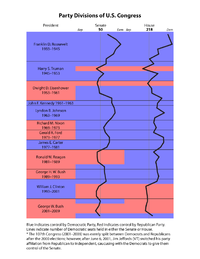- Divided government
-
In the United States, divided government describes a situation in which one party controls the White House and another party controls one or both houses of the United States Congress. Divided government is suggested by some to be an undesirable product of the separation of powers in the United States' political system. Earlier in the 20th century, divided government was rare, but in the late 20th and early 21st centuries it has become increasingly common.
Some conservative and libertarian groups see divided government as beneficial, since it may encourage more policing of those in power by the opposition, as well as limiting spending[1] and the expansion of undesirable laws.[2]
In Parliamentary systems such as the United Kingdom, the executive relies on Parliamentary support for its existence. In the United States, however, the constitution is designed to create conflict between the executive and legislative branches of government.
Despite the perceived problems of divided government, the President and Congress are often able, out of necessity, to establish an effective working relationship.
Contents
Unified and Divided Party Control of the U.S. Government since 1901
D denotes the Democratic Party and R denotes the Republican Party.
Year President Senate House 1901–1903 R R R 1903–1905 R R R 1905–1907 R R R 1907–1909 R R R 1909–1911 R R R 1911-1913 R R D 1913–1915 D D D 1915–1917 D D D 1917–1919 D D D 1919-1921 D R R 1921–1923 R R R 1923–1925 R R R 1925–1927 R R R 1927–1929 R R R 1929–1931 R R R 1931-1933 R R D 1933–1935 D D D 1935–1937 D D D 1937–1939 D D D 1939–1941 D D D 1941–1943 D D D 1943–1945 D D D 1945–1947 D D D 1947-1949 D R R 1949–1951 D D D 1951–1953 D D D 1953–1955 R R R 1955-1957 R D D 1957-1959 R D D 1959-1961 R D D 1961–1963 D D D 1963–1965 D D D 1965–1967 D D D 1967–1969 D D D 1969-1971 R D D 1971-1973 R D D 1973-1975 R D D 1975-1977 R D D 1977–1979 D D D 1979–1981 D D D 1981-1983 R R D 1983-1985 R R D 1985-1987 R R D 1987-1989 R D D 1989-1991 R D D 1991-1993 R D D 1993–1995 D D D 1995-1997 D R R 1997-1999 D R R 1999-2001 D R R 2001-2003 R D* R 2003–2005 R R R 2005–2007 R R R 2007-2009 R D D 2009–2011 D D D 2011-2013 D D R *Democrats control the Senate for only 17 days in January, since Al Gore was still Vice President and President of the Senate. But the Republicans won control the chamber with the tie-breaking vote of the new Vice President Richard B. Cheney on January 20. The small Republican Majority would only last until May 24, 2001 when Republican Senator Jim Jeffords of Vermont left the Republican Party and became an Independent who chose to caucus with the Democrats.
More information
Party divisions of United States Congresses
References
Further reading
- Morris Fiorina, Divided Government, 1996.
- David R. Mayhew, Divided We Govern, 1991.
Categories:- Political science terms
- Government of the United States
Wikimedia Foundation. 2010.

